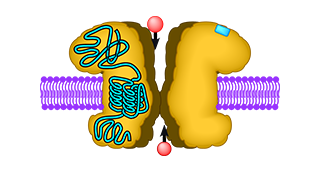Publication of the Year 2003
N. Strutz-Seebohm, M. Werner, D.M. Madsen, G. Seebohm, Y. Zheng, C.S. Walker, A.V. Maricq, and M. Hollmann (2003).
Functional analysis of Caenorhabditis elegans glutamate receptor subunits by domain transplantation.
Journal of Biological Chemistry 278(45): 44691-44701.
doi: 10.1074/jbc.M305497200
Abstract
Ionotropic glutamate receptors (GluRs) are not only abundant and important mediators of fast excitatory synaptic transmission in vertebrates, but serve a similar function in invertebrates such as the nematode Caenorhabditis elegans. In C. elegans, 10 different GluR subunits have been identified and cloned. To study the ion channel properties of these receptor subunits, we recorded glutamate-gated currents from Xenopus oocytes that expressed either native C. elegans GluR subunits or chimaeric rat/nematode GluR subunits constructed between the C. elegans GluR pore domains and rat GluR subunits. While native subunits were non-functional, nine out of ten ion pores were found to conduct current upon transplantation into rat receptor subunits. C. elegans GluR ion pores, at a position homologous to a highly conserved site critical for ion permeation properties in vertebrate GluR pores, contain amino acids not found in vertebrate GluRs. We show that the pore-constricting Q/R site, which in vertebrate GluRs determines calcium permeability and rectification properties of the ion channel, in C. elegans can be occupied by other amino acids, including, surprisingly, lysine and proline, without loss of these properties.



